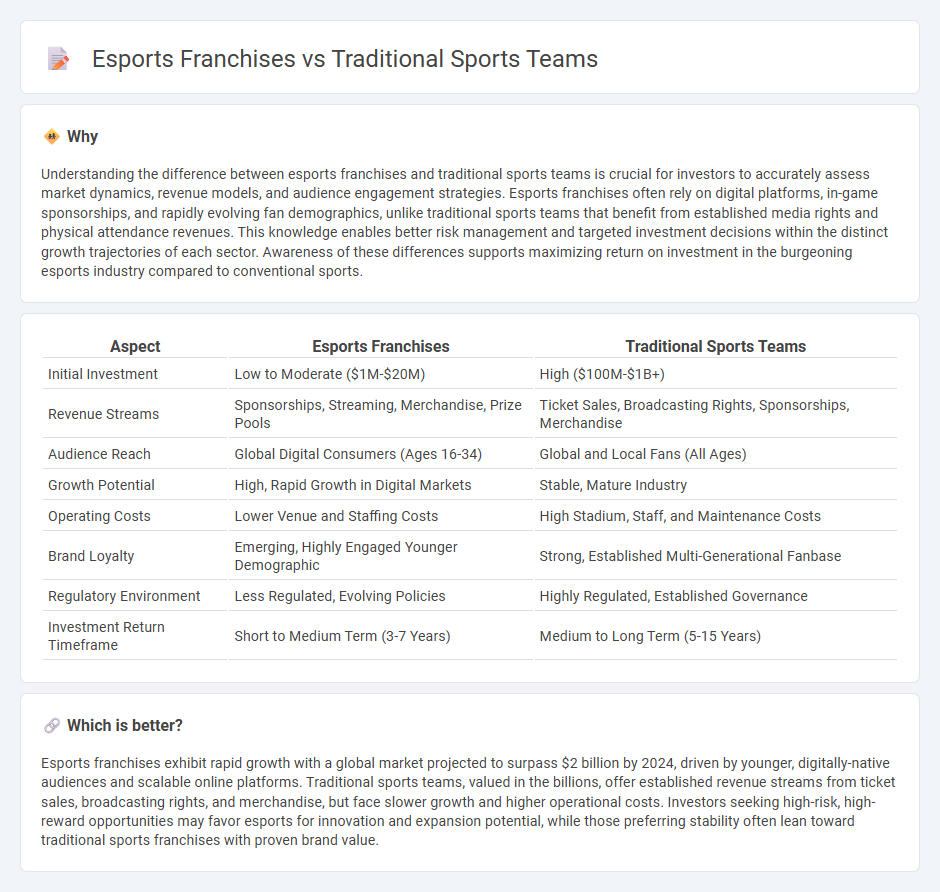
Esports franchises have rapidly gained value, with top teams like TSM and FaZe Clan attracting multi-million dollar investments, rivaling traditional sports franchises such as NFL and NBA teams. The digital-native audience and global reach of esports create unique revenue streams, including sponsorships, media rights, and merchandise sales, driving substantial returns for investors. Explore the evolving landscape of investment opportunities comparing esports franchises and traditional sports teams to understand where the future growth lies.
Why it is important
Understanding the difference between esports franchises and traditional sports teams is crucial for investors to accurately assess market dynamics, revenue models, and audience engagement strategies. Esports franchises often rely on digital platforms, in-game sponsorships, and rapidly evolving fan demographics, unlike traditional sports teams that benefit from established media rights and physical attendance revenues. This knowledge enables better risk management and targeted investment decisions within the distinct growth trajectories of each sector. Awareness of these differences supports maximizing return on investment in the burgeoning esports industry compared to conventional sports.
Comparison Table
| Aspect | Esports Franchises | Traditional Sports Teams |
|---|---|---|
| Initial Investment | Low to Moderate ($1M-$20M) | High ($100M-$1B+) |
| Revenue Streams | Sponsorships, Streaming, Merchandise, Prize Pools | Ticket Sales, Broadcasting Rights, Sponsorships, Merchandise |
| Audience Reach | Global Digital Consumers (Ages 16-34) | Global and Local Fans (All Ages) |
| Growth Potential | High, Rapid Growth in Digital Markets | Stable, Mature Industry |
| Operating Costs | Lower Venue and Staffing Costs | High Stadium, Staff, and Maintenance Costs |
| Brand Loyalty | Emerging, Highly Engaged Younger Demographic | Strong, Established Multi-Generational Fanbase |
| Regulatory Environment | Less Regulated, Evolving Policies | Highly Regulated, Established Governance |
| Investment Return Timeframe | Short to Medium Term (3-7 Years) | Medium to Long Term (5-15 Years) |
Which is better?
Esports franchises exhibit rapid growth with a global market projected to surpass $2 billion by 2024, driven by younger, digitally-native audiences and scalable online platforms. Traditional sports teams, valued in the billions, offer established revenue streams from ticket sales, broadcasting rights, and merchandise, but face slower growth and higher operational costs. Investors seeking high-risk, high-reward opportunities may favor esports for innovation and expansion potential, while those preferring stability often lean toward traditional sports franchises with proven brand value.
Connection
Esports franchises and traditional sports teams share investment strategies focused on brand expansion, audience engagement, and diversified revenue streams. Both sectors utilize sponsorship deals, media rights, and merchandise sales to maximize financial growth and fan loyalty. Cross-industry collaborations enhance market reach, leveraging the global popularity of esports alongside the established fan bases of traditional sports teams.
Key Terms
Revenue Streams
Traditional sports teams generate revenue primarily through ticket sales, merchandise, broadcasting rights, and sponsorship deals, capitalizing on long-established fan bases and live event experiences. Esports franchises derive income mainly from digital content monetization, such as streaming, advertising, game publisher partnerships, and franchise league fees, reflecting the rapidly growing and global online audience. Explore the evolving financial landscapes to understand how both industries maximize profitability through distinct revenue models.
Valuation Metrics
Traditional sports teams are often valued based on revenue streams such as ticket sales, broadcasting rights, and merchandise, with Forbes estimating the Dallas Cowboys at $9 billion in 2023. Esports franchises, like those in the Overwatch League or League of Legends Championship Series, derive value from digital advertising, streaming partnerships, and brand sponsorships, with top teams like TSM valued at around $410 million. Discover more about how these different valuation models impact investment opportunities in the evolving sports industry.
Audience Demographics
Traditional sports teams attract diverse audiences often spanning multiple age groups, with a strong preference among older demographics and regional fan bases. Esports franchises primarily engage younger, tech-savvy viewers aged 18 to 34, who are highly active on digital platforms and social media. Discover more about how these audience demographics shape marketing strategies and fan engagement in both industries.
Source and External Links
Team sport - Wikipedia - Traditional team sports such as basketball, rugby, baseball, various forms of football, and hockey have ancient origins and have played significant social, cultural, and political roles in civilizations worldwide, from ancient Greece and Rome to China and Mesoamerica.
Europe - Traditional Sports - Europe has a wealth of traditional team sports including bandy, considered one of the oldest hockey sports on ice, with historical roots tracing back to ball and stick games played on frozen ponds and plains since ancient times.
North America - Traditional Sports - Indigenous traditional team sports in North America include Anejodi, a team ball game originating with Native American warriors, and Carrera de Arihueta, a tribal running competition from Mexico, reflecting the deep cultural heritage of the region's peoples.
 dowidth.com
dowidth.com